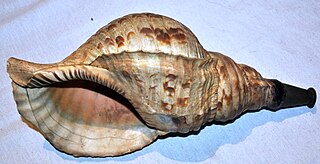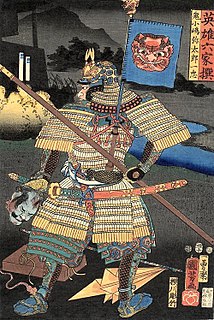 W
WThe gunbai military leader's fan ; umpire's fan is a type of signal Baton and Japanese war fan, once held by military leaders and priests in old Japan, in modern day used by umpires in sumo wrestling.
 W
WHata-jirushi (旗印) were the most common of war banners used on the medieval Japanese battlefield. The term can be translated to literally mean symbol flag, marker banner, or the like. Unlike the later nobori, which were stiffened, these banners were simple streamers attached to a shaft by a horizontal cross-piece. Later, some hata-jirushi were hemmed on the sides to create a sleeve for a pole on the side and top, or had pieces of fabric attaching their side and top to poles to make the banners visible from the front. There are two variants of the Hata-jirushi: One end of the cross-piece was attached to the shaft or the cross-piece was suspended from the shaft, similar to the Vexillum.
 W
WHoragai (法螺貝) are large conch shells, usually from Charonia tritonis, that have been used as trumpets in Japan for many centuries. The instrument, which has served a number of purposes throughout Japanese history, has been given a number of Japanese names depending on its function. Special schools still teach students to play the traditional music associated with the conch.
 W
WA horo (母衣) was a type of cloak or garment attached to the back of the armour worn by samurai on the battlefields of feudal Japan.
 W
WJapanese War Fans, or Tessen is a weaponized Japanese hand fan designed for use in warfare. Several types of war fans were used by the samurai class of feudal Japan and each had a different look and purpose.
 W
WMon (紋), also monshō (紋章), mondokoro (紋所), and kamon (家紋), are Japanese emblems used to decorate and identify an individual, a family, or an institution or business entity. While mon is an encompassing term that may refer to any such device, kamon and mondokoro refer specifically to emblems used to identify a family. An authoritative mon reference compiles Japan's 241 general categories of mon based on structural resemblance, with 5116 distinct individual mon.
 W
WNobori (幟) is a Japanese banner. They are long, narrow flags, attached to a pole with a cross-rod to hold the fabric straight out and prevent it from furling around the rod; this way, the field is always visible and identifiable.
 W
WA saihai (采配) was a baton carried by samurai commanders in feudal Japan, now used by Kannushi in formal settings. The saihai or sai-hai was a sign of rank and a signal device.
 W
WSashimono were small banners historically worn by soldiers in feudal Japan, for identification during battles.
 W
WUma-jirushi were massive flags used in feudal Japan to identify a daimyō or equally important military commander on the field of battle. They came into prominence during the Sengoku period. While many were simply large flags, not very different from sashimono or hata-jirushi, most were three-dimensional figures, more like kites, and in the shape of bells, gongs, umbrellas, or streamers.